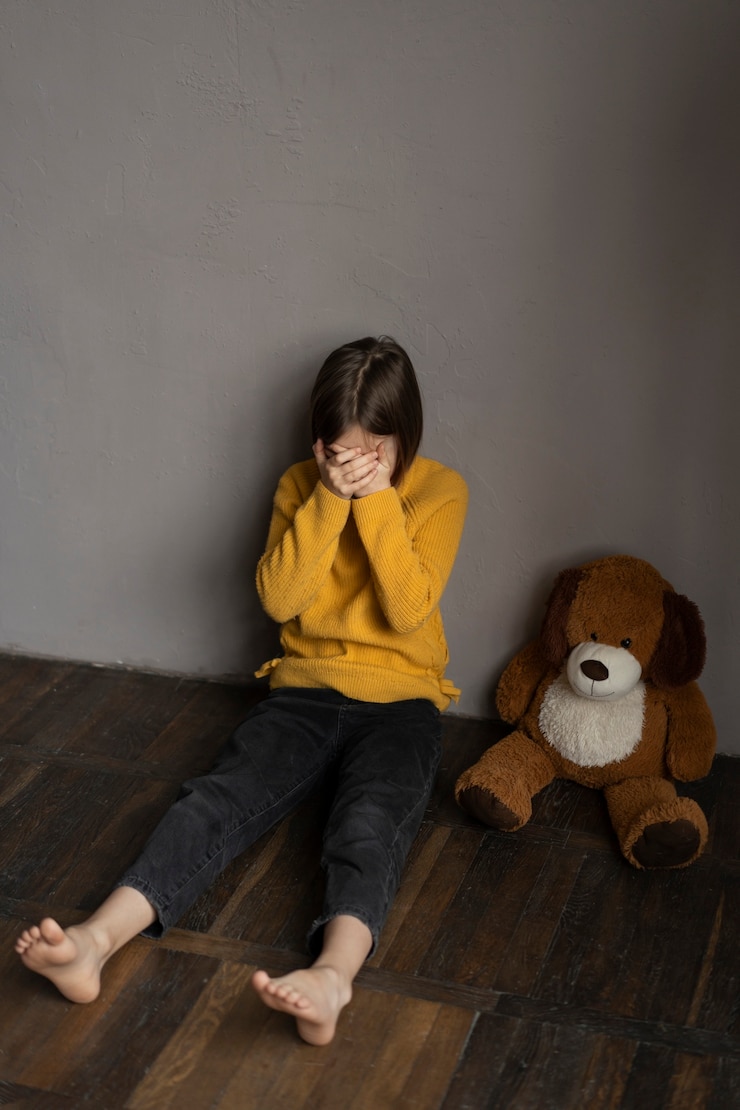
Anxiety can manifest in children from a young age, sometimes in obvious ways and other times through more subtle or unexpected signs. Below are 10 anxiety symptoms in children that parents might miss.
### Table of Contents
**”Could my child really have anxiety?”**
This is often the first thought parents have when they visit my therapy office, looking to understand their child’s perplexing and challenging actions. Many times, parents have tried to manage these behaviors with reward systems, consequences, and sticker charts, only to find that the behaviors persist or worsen.
It’s understandable that parents might overlook anxiety symptoms in children, given our usual mental images of an overwhelmed, worried child. For instance, imagine a preschooler wearing rainboots, hiding behind their parent on the first day of school. That’s the stereotypical picture of anxiety.
When I talk to parents, they are often surprised to learn that their child’s ‘misbehaviors’ can be better explained as ‘distressed behaviors.’ This is because the child’s nervous system is reacting to stress. A child in fight or flight mode can seem defiant and uncooperative. When our brains sense a threat, our bodies react as if we’re in real danger. This is what anxiety does.
Our amygdala, which is the part of the brain responsible for emotions, plays a protective role through survival instincts. However, factors like genetics, environment, health, and temperament can cause the amygdala to be overactive, making it difficult to distinguish between real and perceived threats. When this happens frequently, it leads to survival-type behaviors.
Here are 10 anxiety symptoms in children that often confuse parents but actually stem from our body’s fight-flight-freeze response (as supported by scientific research).
One of the most common symptoms that surprises parents is emotional reactivity. Living with constant anxiety and overwhelm naturally makes one more emotionally sensitive. When a child’s emotional center goes into overdrive due to anxiety, they are more likely to be irritable and quick to react.
###### Related Read: Anger Management for Kids: A Therapist’s No-Fail Guide to Calm
Questions like “Mom, how many minutes until we get there?” are common among kids. However, a child with anxiety might ask this 25 times during a one-hour drive. Uncertainty can be very uncomfortable for them, and they cope by repeatedly seeking reassurance.
Statements like, “Do you think I’ll make friends at soccer?” or “Are you sure I won’t miss you at camp?” highlight another common symptom—excessive reassurance seeking. This is typical of generalized anxiety and certain types of Obsessive-Compulsive Disorder (OCD), where recurring anxious thoughts drive the need for reassurance for temporary relief.
###### Check Out: 75 Calm Down Strategies for Kids (They’ll Want to Try!)
When the brain triggers a fight or flight response, several physical changes occur in the body. For example, during stress, the digestive system might slow down to conserve energy and redirect blood flow to the brain, which is why anxious children often complain of stomach aches.
###### Related: 5 Ways to Lower Your Child’s Anxiety Today
Avoidance is another coping strategy children with anxiety employ, which can often be mistaken for defiance. Examples include “I’m not doing that!” or “You can’t make me, you’re not the boss of me.” This behavior arises when a child attempts to gain control due to feeling inwardly unsettled.
###### Want Practical Tools? Get My ‘Calm Kids Set’ at 40% Off for a Limited Time
Anxious thoughts often invade when the mind is quiet, such as at bedtime, making it hard for children to relax and sleep peacefully. Nighttime waking is common as their hyper-alert brains react to stimuli like noises or dreams.
###### Help for Childhood Anxiety? Check Out Courses by Expert Natasha Daniels
Living in constant stress keeps a child’s brain in survival mode, causing the emotional center to be overly active. This reduces the accessibility of the ‘thinking brain,’ which is why anxiety makes focusing, impulse control, and organization harder.
Tears may flow unexpectedly during daily routines. A brain in emotional overdrive needs outlets for all emotions, and common situations can easily trigger this release.
Running away, whether at home or school, is the ‘flight’ in fight or flight. When overwhelmed, a child’s brain urges them to escape the situation for survival.
###### Related: 100 Everyday Ways to Strengthen Your Child’s Mental Health
A child might say, “I want to stay with you and not go to school,” as having a caregiver nearby offers comfort. The thought of being alone at school can be overwhelming, affecting their ability to reason.
It’s easy to misinterpret shutting down or acting out as intentional behavior. However, these are often signs of anxiety. Recognizing the neurological causes of anxiety helps in understanding it’s not merely a behavioral issue but a real condition.
Most children show these behaviors to some extent as they grow. The key difference with anxiety is when these behaviors significantly impact a child’s daily life across multiple areas, more often than not, over an extended period. If you suspect your child has anxiety, remember that it is common and treatable with the right support and treatment.
Karen Young from Hey Sigmund beautifully puts it, “Anxiety is the work of a strong, healthy brain that’s a little overprotective.”
### Additional Resources:
If your child experiences anxiety, explore Karen Young’s book ‘Hey Warrior,’ which uses beautiful storytelling and imagery to teach kids about anxiety and how to manage it.
—
**Sign Up to Support Your Child:**
Join over 30k parents in the ‘Parents with Confidence’ weekly email and receive a FREE 5-day parenting course. Learn about safeguarding your child’s self-esteem, gaining their cooperation, important future skills, and effective, non-harmful discipline strategies.
**Opt-in today and get these insights straight to your inbox.**
*No spam, unsubscribe anytime. Built with Kit.*



